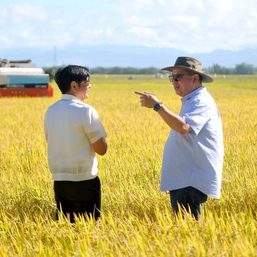SUMMARY
This is AI generated summarization, which may have errors. For context, always refer to the full article.

MANILA, Philippines – Following four straight months of rising inflation, the rate of increase in the prices of goods and services finally eased to 3.7% in June.
The latest figure is lower than the 3.9% recorded in May 2024 and the 5.4% in June 2023.
The Philippine Statistics Authority said in a briefing on Friday, July 5, that the main sources of the slowdown were the lower inflation rates for housing, water, electricity, gas, and other fuels (from 0.9% in May to 0.1% in June); transport (from 3.5% to 3.1%); and restaurants and accommodation services (from 5.3% to 5.1%).
Year-to-date, average inflation is 3.5%, which keeps it within the government’s goal of 2% to 4%. For the past few months, inflation has been lingering at the higher end of this target range.
In the National Capital Region, inflation also dipped from 3.1% in May to 2.3% in June, while in areas outside NCR, inflation was unchanged at 4.1%.
By region, the Bangsamoro Autonomous Region in Muslim Mindanao continued to have the highest inflation at 5.3% in June, although this is lower than May’s 5.9%.
The Ilocos Region posted the lowest inflation outside NCR at 2.8%, but this is higher than the previous figure of 2.3%.

While inflation eased on a national level, it inched up for the Philippines’ poorest. The rate for the bottom 30% income households was at 5.5% in June from 5.3% in May.
Rising food prices
The uptick in food prices also remains a concern. Food inflation rose from 6.1% in May to 6.5% in June, primarily due to higher prices of vegetables and meat.
The National Economic and Development Authority (NEDA) said in a statement on Friday that the onset of the rainy season affected supply and pushed the inflation rate of vegetables to 7.2% in June from 2.7% in May.
For meat, the increase to 3.1% from 1.6% was driven by higher inflation for pork (3.9% from 2.4%), chicken (2.4% from -0.3%), and beef (2.8% from 2.6%).
“Pork inflation rose amid the rise in active African swine fever cases. Chicken inflation increased as the temporary import ban on poultry products from the United States and Australia affected supply,” NEDA said.
In contrast, rice inflation slightly declined to 22.5% in June from 23% in May. However, it was the top contributor to the inflation rate for the month. (READ: High rice inflation could linger until July as market prices keep going up)

“We will continue to work closely with the government, stakeholders, and other priority sectors to implement necessary measures to ensure that the country will have a sufficient and affordable food supply – including rice – for every Filipino,” NEDA Secretary Arsenio Balisacan said.
Longer-term outlook
The Bangko Sentral ng Pilipinas (BSP) earlier estimated inflation in June would settle between 3.4% and 4.2%.
But the BSP is more optimistic when it comes to the longer-term inflation outlook. The central bank cut its risk-adjusted inflation forecast to 3.1% for both 2024 and 2025 from 3.8% and 3.7%, respectively.
The reason for the renewed optimism is the reduction in import tariffs on rice – a commodity whose price can determine the way in which inflation swings.
“The latest inflation outturn is consistent with the BSP’s latest outlook that inflation will settle within the target range for 2024 to 2025 with inflation expectations remaining well-anchored,” the central bank said in a statement on Friday.
“The balance of risks to the inflation outlook has shifted to the downside for 2024 and 2025 due largely to the impact of lower import tariffs on rice…. Nonetheless, higher prices of food items other than rice, transport charges, and electricity rates continue to pose upside risks to inflation.”
The improved inflation outlook has also led the central bank to adopt a more dovish stance, with BSP Governor Eli Remolona Jr. hinting that a key policy rate cut in August is now “somewhat more likely than before.” – Rappler.com
Add a comment
How does this make you feel?


![[In This Economy] Runaway rice prices are making inflation higher than it needs to be](https://www.rappler.com/tachyon/2024/02/tl-rice-prices.jpg?resize=257%2C257&crop=560px%2C0px%2C720px%2C720px)
![[ANALYSIS] A soft and range-bound stock market that has not lost its luster](https://www.rappler.com/tachyon/2024/02/TL-market-soft-range-bound-February-9-2024.jpg?resize=257%2C257&crop_strategy=attention)
![[In This Economy] Marcos Year 2: Missed targets, missing reforms](https://www.rappler.com/tachyon/2024/07/TL-Marcos-Year-2-missed-targets-missing-reforms-July-5-2024.jpg?resize=257%2C257&crop=134px%2C0px%2C720px%2C720px)

![[Vantage Point] BBM Year 2: Hits and misses](https://www.rappler.com/tachyon/2024/06/thought-leaders-marcos-hits-and-misses.jpg?resize=257%2C257&crop=277px%2C0px%2C720px%2C720px)

There are no comments yet. Add your comment to start the conversation.